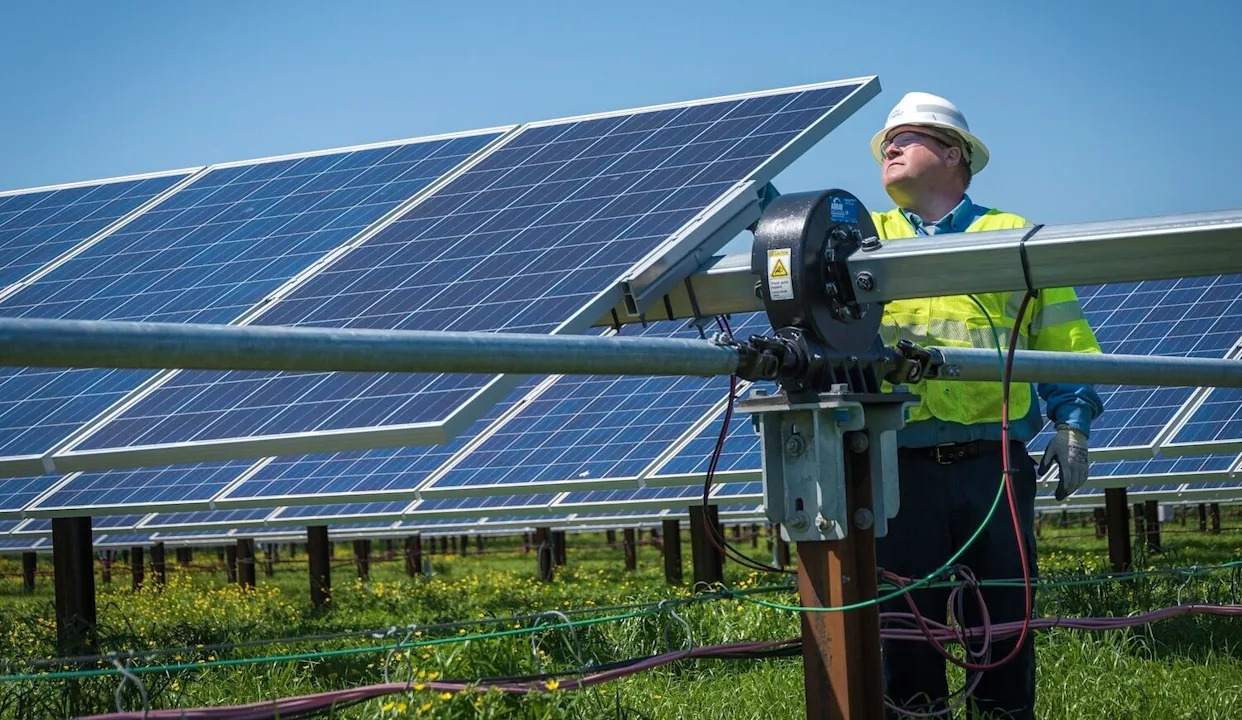
There’s no sugarcoating it: A new North Carolina law unraveling utility Duke Energy’s climate goals is a massive setback for the state’s clean energy transition, and it’s being exacerbated by the Trump administration’s full-scale assault on wind and solar power across the country.
Yet many observers believe that in the short term the renewable energy sector will bend but not break — buoyed by the realities of rising electricity demand and the increasingly bleak economics of fossil fuels.
The Republican-led legislature passed Senate Bill 266 last month, overriding the veto of Gov. Josh Stein, a Democrat. The legislation erases a 2030 deadline by which Duke must cut its carbon emissions by 70% compared to 2005 levels, though it retains a mandate for the utility to decarbonize by midcentury.
Those deadlines were set into state law in resounding bipartisan fashion only four years ago, with just over two dozen “no” votes in the GOP-controlled House and Senate combined.
But it was a different era politically. Democrat Joe Biden had just won the presidency, spurred in part by voters animated by the climate crisis. Then-Gov. Roy Cooper, a Democrat, had made promoting the clean energy economy a signature of his administration, and his party held enough seats in both chambers to sustain his veto.
Elected in 2024, Stein has made no secret of his support for clean energy, but his focus to date has been recovery after Hurricane Helene, which struck the state nearly a year ago. Republicans in the General Assembly are only one vote shy of a supermajority. President Donald Trump’s stunning attack on wind, solar, and climate science has given license to like-minded allies in his party and in powerful state industrial groups to follow his lead.
The utility landscape has also shifted dramatically. In 2021, Duke, ever-influential with lawmakers, was willing to compromise on a wide-ranging energy bill to secure approval for a long-sought multiyear ratemaking scheme. Before a cleantech manufacturing resurgence and the explosion of AI, the company also faced relatively flat electric demand. State utility regulators, all but one appointed by Cooper, appeared inclined toward climate action, even if they sometimes frustrated advocates.
A new political and energy reality
Today, Republican-appointed members — including one with an apparent axe to grind against solar — comprise the majority on the Utilities Commission. After the passage of SB 266, the panel wasted no time in ordering Duke to stop near-term planning for cutting its carbon emissions by 70%.
Duke still must zero out its climate-warming pollution by 2050, and its latest plan for doing so is due Oct. 1. But if predictions from Public Staff, the state-sanctioned customer advocate, are any indication, removing the near-term goal could mean seismic changes to the company’s forecast for the next decade.
With the blessing of regulators, the company was already on pace to miss the interim target by five years. Without any midway goal, Duke could build about 12 fewer gigawatts of new power capacity by 2035 and lean harder on aging fossil-fuel plants and purchased power instead. The forgone generation includes 4.4 gigawatts of solar, 2.8 gigawatts of battery storage, and 4.5 gigawatts of wind, according to Public Staff.
Advocates are working hard to make sure those predictions don’t come true.
One dynamic that may help is the urgency of rising electricity demand. According to June figures from Duke, new economic development projects in the form of data centers and other large customers could require roughly 6 new gigawatts of capacity by 2030.
Yet wait times for new natural gas turbines are as long as seven years, according to S&P Global. And Duke plans to be a so-called second mover on small modular nuclear reactors — meaning it doesn’t foresee becoming the first U.S. utility to put the nascent resource into service. A new reactor won’t come online for at least 10 years, per the company.
“It’s a matter of meeting a deficit”
Even if the most extreme predictions about new economic development don’t pan out, solar and battery storage, and even onshore wind, are all poised to fill a need left by these delays, advocates say.
“It's a matter of meeting a deficit — a potential deficit — in energy demand,” said Karly Brownfield, a senior program manager with Southeastern Wind Coalition, a nonprofit that advocates for the industry. With similar development timelines as gas and a well-established and tested permitting process in the state, she said, “I think onshore wind is definitely going to continue to move to the front.”
Another factor favoring renewables: cost. While the tax and spending bill signed by Trump this summer indubitably scrambles the calculus on wind and solar by phasing out tax incentives more quickly than before and making them harder for developers to access, these resources are still cheaper than new fossil-fueled plants — even without subsidies. The cost of battery storage, meanwhile, continues to decline.
At the same time, the specter of rising natural gas prices should loom large, says Josh Brooks, chief of policy strategy and innovation with the North Carolina Sustainable Energy Association. “The passage of SB 266 puts into sharp focus retail ratepayer exposure to fuel-price volatility,” he said. “The best and quickest opportunity to address that risk is through distributed renewables — especially solar paired with storage.”
Brownfield is also not giving up on offshore wind, despite the Trump administration’s aggressive antipathy for ocean-based turbines and Duke’s recent decision not to solicit any offshore projects in the near term. The three developers who hold leases off North Carolina’s coast have spent relatively little on their projects so far, Brownfield said. They can bide their time until the politics and the economics become more favorable.
“They’re early enough in the process that they feel like they can mitigate that risk over the next couple of years,” Brownfield said. “The conversation about offshore wind is not going to go away.”
Advocates also point to the colossal economic development impact of renewables in the state — from the farmers who increase their profit margins by leasing land for turbines or solar panels to the county commissioners looking to fund public schools. An analysis released just before lawmakers passed SB 266 showed the law could cut investment in power plant construction by more than $47.2 billion between 2030 and 2035, and reduce tax revenue by more than $1.4 billion — mostly because of forgone renewable energy development.
In hurricane-prone North Carolina, resiliency concerns loom large, too, said Brooks, who noted the success of solar microgrids and other climatetech in the wake of Helene’s devastation. “There's no doubt about it that that was the quickest way to respond to Helene,” he said. “As incidents like that increase, we're only going to see more need for the utility to think about decentralized assets.”
Regulatory decisions on the horizon
Even without the 2030 carbon goal, clean energy advocates will have several chances over the next year to advance these arguments before the Utilities Commission.
An analysis of Duke’s large load growth projections is ongoing, and an expert witness hearing is scheduled for October. The company’s latest draft plan for phasing out climate-warming emissions comes this fall and must be finalized by the end of 2026. What’s more, Duke is proposing to merge its two separate utilities in North Carolina, and could soon proffer another three-year rate increase to begin in 2027.
“There’s going to be tens of billions of dollars of investment decisions made at the regulatory level in the next year,” said Will Scott, Southeast climate and clean energy director for Environmental Defense Fund.
Regulators have also directed the company to test gas-fired plants that can be fueled with hydrogen. If that experiment ultimately proves unworkable, it could force Duke to abandon its apparent plan to convert its fossil-fueled plants to hydrogen at the last minute to comply with the midcentury carbon deadline.
“Given how big a piece hydrogen was in their 2050 plan, in terms of reducing emissions from the new proposed gas units, that’s going to be good to keep an eye on,” Scott said.
Still, the immediate future of renewables is likely to depend most on Duke itself, whose sway with regulators appears steadfast as ever. And the company’s shareholders, who per one Wall Street firm secured a “more predictable earnings trajectory” from the passage of SB 266, could pull away from wind and solar and toward more robust investments in fossil fuels.
What’s more, the current political climate, as set by the White House, could embolden anti-clean-energy lawmakers to push to eliminate Duke’s carbon goals entirely before possible Republican losses in next year’s midterms.
Advocates are clear-eyed about that risk. But they also point to electric bills that are already rising and predicted to climb even more under SB 266, especially for households. That could create the impetus for bipartisan legislation to course correct.
“I can easily foresee a world where we do not have to engage much to get parts of this bill overturned in a future session once the economic realities of it hit the ratepayers,” Brooks said.








Comments